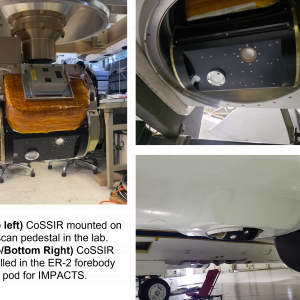Primary tabs
Disclaimer: This material is being kept online for historical purposes. Though accurate at the time of publication, it is no longer being updated. The page may contain broken links or outdated information, and parts may not function in current web browsers. Visit https://espo.nasa.gov for information about our current projects.
Configurable Scanning Submillimeter-wave Instrument/Radiometer (CoSSIR)
Status
The Configurable Scanning Submillimeter-wave Instrument/Radiometer (CoSSIR) is an airborne, 16-channel total power imaging radiometer that was primarily developed for the measurement of ice clouds. CoSSIR was first flown in CRYSTAL-FACE (Cirrus Regional Study of Tropical Anvils and Cirrus Layers – Florida Area Cirrus Experiment) in 2002, followed by CR-AVE (Costa Rica Aura Validation Experiment) in 2006, and TC4 (Tropical Composition, Cloud and Climate Coupling Experiment) in 2007. For CRYSTAL-FACE and CR-AVE, CoSSIR had 15 channels centered at 183±1, 183±3, 183±6.6, 220, 380±.8, 380±1.8, 380±3.3, 380±6.2, 487.25±0.8, 487.25±1.2, 487.25±3.3, and 640 GHz, where the three 487 GHz channels were dual-polarized (vertical and horizontal). For TC4, the 487 GHz channels were removed, 640 GHz was made dual-polarized, and an 874 GHz channel was added.
In 2022, CoSSIR was completely updated with new receivers under funds through the Airborne Instrument Technology Transition (AITT) to improve measurement accuracy and enable CoSSIR to be a stand-alone sensor that no longer shared a scan pedestal with its millimeter-wave sibling, CoSMIR. Frequencies were selected for CoSSIR to optimize snow and cloud ice profiling, and dual-polarization capability was added for all frequencies to provide information on particle size and shape. New channels are centered at 170.5, 177.3, 180.3, 182.3, 325±11.3, 325±3.55, 325±0.9, and 684 GHz. The updated CoSSIR flew for the first time in the 2023 deployment of IMPACTS (Investigation of Microphysics and Precipitation for Atlantic Coast Threatening Snowstorms) and operated nominally for the entire campaign, collecting a wide variety of observations over different types of clouds and precipitation.
All the receivers and radiometer electronics are housed in a small cylindrical scan head (21.5 cm in diameter and 28 cm in length) that is rotated by a two-axis gimbaled mechanism capable of generating a wide variety of scan profiles. Two calibration targets, one maintained at ambient (cold) temperature and another heated to a hot temperature of about 323 K, are closely coupled to the scan head and rotate with it about the azimuth axis. Radiometric signals from each channel are sampled at 10 ms intervals. These signals and housekeeping data are fed to the main computer in an external electronics box.


